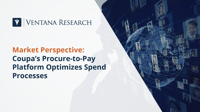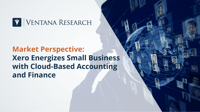As an organization transitions from being smaller and more informally managed to a larger business, it typically needs formal processes and controls. These ensure accurate financial reporting and protect the organization’s assets. These controls include, for example, systematic reviews and approvals, a second signature for the disbursement of material amounts, supervision when creating and removing customer accounts and three-way matching of invoices.
Read More
Topics:
Office of Finance,
ERP and Continuous Accounting,
digital finance,
Consolidate/Close/Report
Today, technology has the ability to significantly increase the efficiency with which organizations handle expenditures while simultaneously containing costs, increasing controls and improving visibility into where the money is going. Procure-to-pay software enables organizations to manage the end-to-end process of requesting, procuring, receiving and paying for goods and services. The related and often interchangeable category of source-to-pay software begins with the process of securing the...
Read More
Topics:
Office of Finance,
Financial Performance Management,
digital finance
The topic of artificial intelligence using machine learning (AI/ML) used to conjure up images of PhDs in white lab coats using massive computers to solve arcane problems, but today’s technology is packaged to be used effectively by those not trained in data science to address daily chores more efficiently. AI will be valuable to finance departments in five general areas: forecasting and planning, analytics, task supervision, recommendations and automated commentary. Although the payoff from...
Read More
Topics:
Office of Finance,
Analytics,
Business Planning,
ERP and Continuous Accounting,
AI & Machine Learning,
digital finance
Indirect taxes — known variously as sales-and-use, value-added or goods-and-services tax — can get complicated, particularly in countries that have overly complex tax regimes such as Brazil, India and the United States. For example, in the U.S., state and local governments have their own statutes defining which goods are taxed and at what rates, and taxable items and rates change all the time. More recently, compliance has grown more complex with the Supreme Court’s Wayfair decision, which...
Read More
Topics:
Office of Finance,
Business Planning,
Financial Performance Management,
ERP and Continuous Accounting,
Revenue,
profitability management,
digital finance,
Lease & Tax Accounting
Financial consolidation is the process of combining financial data (notably assets, liabilities, income and expenses) from multiple subsidiaries’ general ledgers across an organization for the purpose of creating a parent company report. The current reality for financial consolidation and close processes is that many organizations still rely on manual spreadsheets, which can lead to longer closing periods, errors and confusion. According to SVP & Research Director in the Office of Finance...
Read More
Topics:
Office of Finance,
Business Planning,
Financial Performance Management,
ERP and Continuous Accounting,
Revenue,
profitability management,
digital finance,
Lease & Tax Accounting
The annual Ventana Research Digital Leadership Awards recognize organizations and individuals that utilize technology to advance business and IT. The Digital Leadership Awards showcase the professional leadership and their use of business applications or technology that contribute significantly to improved efficiency, productivity and the performance of their organization. This prestigious award recognizes leaders and pioneers who have contributed to their organization’s success and championed...
Read More
Topics:
Office of Finance,
Business Planning,
Financial Performance Management,
ERP and Continuous Accounting,
profitability management,
digital finance,
Lease & Tax Accounting
Over the past decade, close-management software has evolved to enable even midsize organizations to streamline department processes, operate in a virtual mode, accelerate the accounting close and reduce staff stress. It’s one step toward continuous accounting, which is defined by Office of Finance Research Director Robert Kugel as an approach to managing transactions recording and accounting that takes advantage of current technology to streamline and restructure the accounting function. In...
Read More
Topics:
Office of Finance,
Business Planning,
Financial Performance Management,
ERP and Continuous Accounting,
profitability management,
digital finance
Power ON is software designed for organizations to streamline their business planning, budgeting, forecasting, reviewing and reporting, in order to make these processes more effective and accurate. Organizations do a lot of planning: In addition to the budget, they plan headcount, sales, production and their supply chain, as well as other business functions, and traditionally execute this using spreadsheets as they are a familiar tool. However, spreadsheets make it difficult for individuals to...
Read More
Topics:
Office of Finance,
Business Planning,
Financial Performance Management,
ERP and Continuous Accounting,
revenue and lease accounting,
profitability management,
digital finance
A digital finance and accounting organization is one that uses software to enhance efficiency by eliminating manual operations and automating workflows, improving financial data quality. This is especially relevant to small to midsize organizations that need to minimize administrative overhead yet still have financial controls and operational visibility to achieve and sustain profitable growth. A continuous accounting approach can streamline tasks and processes, reducing time spent on...
Read More
Topics:
Office of Finance,
Analytics,
Digital Technology,
AI & Machine Learning,
digital finance










